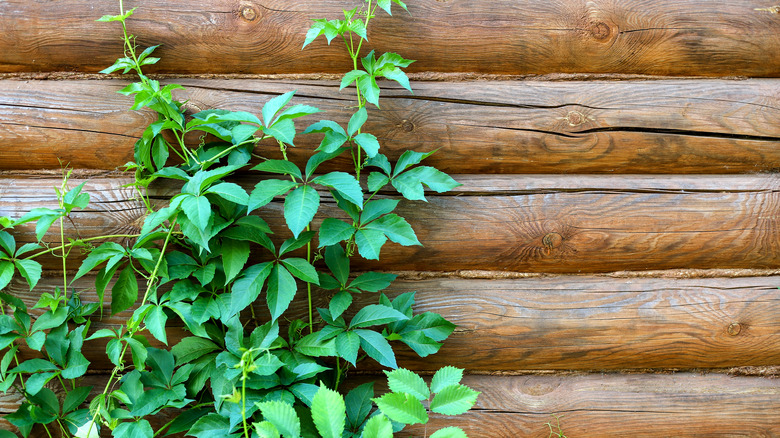11 Important Maintenance Tips If You Own A Log Cabin
Depending on your lifestyle and preferences, your dream home could be anything from a condo in the middle of a bustling city to a secluded treehouse that's tucked away in a tropical jungle. Granted, if you appreciate nature and love to spend as much time as possible surrounded by trees, then you might prefer a log cabin in the woods. There are certainly plenty of benefits to log cabins, whether they're actually in the forest or in the middle of the suburbs.
First and perhaps foremost, a log cabin is an ideal space to seek out rest and relaxation in a cozy environment, according to the Lake Home & Cabin Show. On top of that, it can be both an eco-friendly and energy-efficient choice. Edward Cunningham, an editor at Assignment Help and Revieweal, told Lake Home & Cabin Show, "A log cabin is very good with energy conservation, because of its responses to weather changes. The wood is able to trap heat and keep you warm whenever it's extremely cold outside. And, in hot weather, the coolness from the AC can stay inside, thanks to the log cabin's windows, end trims, and sealants, thus maximizing the home's energy efficiency."
On the other hand, this particular kind of abode also comes along with specific requirements and responsibilities. Check out the following maintenance tips that are important to keep in mind if you have a log cabin.
1. Check for cracks
As wood ages and is exposed to the elements, cracks may appear. The same can happen in the wood that's been used for your log cabin. While minor splits aren't an issue, you'll want to regularly check for larger cracks that might create gaps in problematic areas. If you find any, you can address them as needed.
2. Keep the logs sealed
The stain and sealant that you use for your log cabin can protect the exterior surface of the rustic residence from the sun, rain, and other weather conditions. That's why it's important to check the stain and sealant on your logs. You'll also want to reapply them every few years to ensure their effectiveness.
3. Check the seal between logs
The fit of your logs that was established when it was being built will help to keep out the cold and keep in the heat. However, the seal that's used between the logs is just as important. When you check the sealant on the logs, also check the seal between them and refresh if necessary.
4. Check the windows and doors
As wood gets older and is subjected to a range of weather, it can dry and shrink. While you can take precautions to prevent this from causing major issues, you'll also want to check your log cabin's doors and windows over the years to make sure they're still snug and stable in the wood frame.
5. Clear plants away
Being surrounded by greenery can be one of the benefits of living in a log cabin. At the same time, vines, climbing flowers, and roots can damage your home if they make their way into your foundation or between the logs. To prevent this, regularly clear potentially problematic plants away from the exterior of your home.
6. Trim overhanging branches
Trees can provide shade that will keep your log cabin cool as well as catch some of the snow that might have otherwise ended up on your roof. They can also cause serious damage if they fall on your cabin. By trimming overhanging branches that might be getting old or broken, you can avoid potential problems.
7. Monitor moisture in the ground
An abundance of moisture in the ground around any home can cause issues. However, it can be even more of a problem for a log cabin, which can suffer from rot and become weakened. By monitoring the moisture around the cabin, you can take immediate action if you need to drain water away.
8. Monitor the moisture inside
Excessive moisture can not only damage the outside of your log cabin, but it can also ruin things inside your wood-based abode. Although making sure that your windows, doors, and the logs themselves are properly sealed will help, you may also want to set up a dehumidifier if you need a little extra assistance.
9. Check the roof
Your log cabin's roof may feature asphalt, metal, or clay shingles as well as cedar planks or another material that suits the style, shape, and location. It can also be a key factor when it comes to protecting the logs beneath and ensuring their longevity, which is why you'll want to keep your roof in tip-top condition.
10. Check for bugs and rodents
It's never pleasant to find evidence that bugs, rodents, or other annoying creatures have invaded your home, and that certainly applies to a log cabin. Be sure to check for critters that might cause issues like mice, bats, and termites as they can leave nasty droppings, chew through wires, and nibble on your cabin's logs.
11. Clear debris away
If you have a log cabin, you'll definitely want to keep up on clearing away any debris that accumulates. Leaves, branches, and pine needles can clog your pipes and block your vents or fireplace. If the debris starts to decompose around the outside of your home, it can rot the wood and cause mold or mildew.











